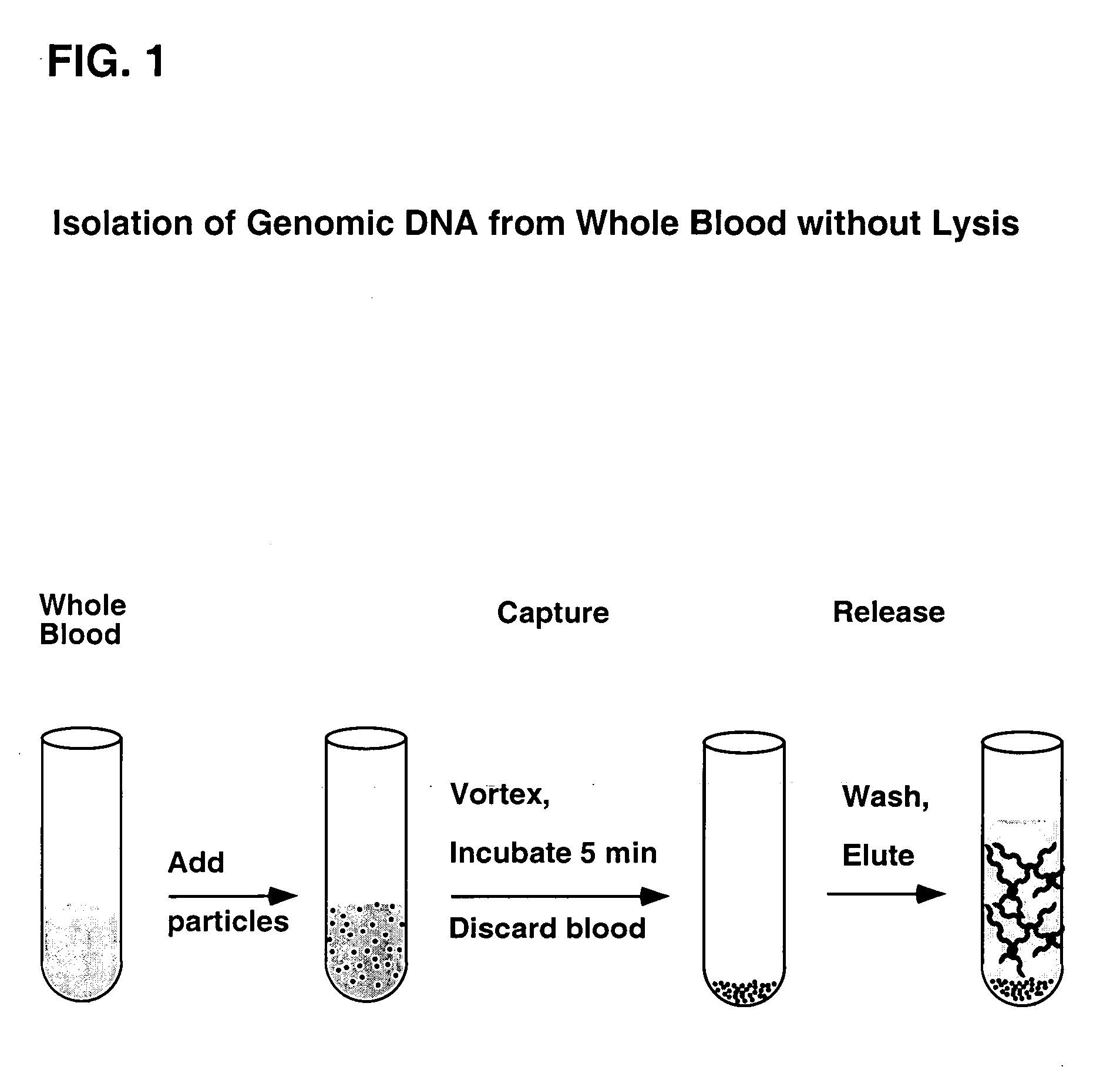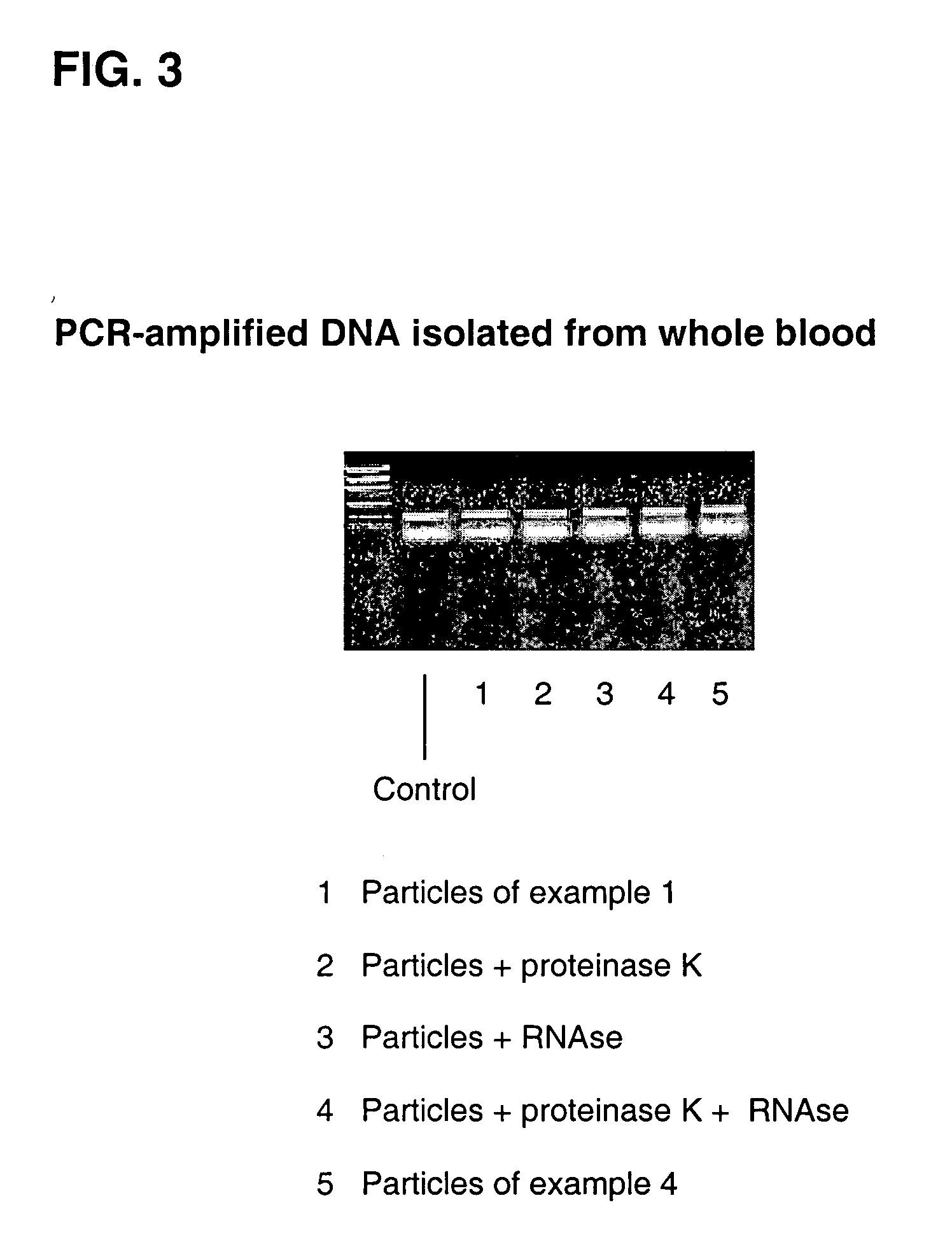Simplified methods for isolating nucleic acids from cellular materials
a nucleic acid and nucleic acid technology, applied in the field of simplified methods for isolating nucleic acids from cellular materials, can solve the problem of undesirable long-chain alkyl groups
- Summary
- Abstract
- Description
- Claims
- Application Information
AI Technical Summary
Problems solved by technology
Method used
Image
Examples
example 1
Synthesis of Magnetic Silica Particles Functionalized with Polymethacrylate Linker and Containing Tributylphosphonium Groups and Cleavable Arylthioester Linkage
[0077]
[0078] Magnetic carboxylic acid-functionalized silica particles (Chemicell, SiMAG-TCL, 1.0 meq / g, 1.5 g) were placed in 20 mL of thionyl chloride and refluxed for 4 hours. The excess thionyl chloride was removed under reduced pressure. The resin was resuspended in 25 mL of CHCl3 and the suspension dispersed by ultrasound. The solvent was evaporated and ultrasonic wash treatment repeated. The particles were dried under vacuum for further use.
[0079] The acid chloride functionalized particles were suspended in 38 mL of CH2Cl2 along with 388 mg of diisopropylethylamine. 4′-Hydroxyphenyl 4-chloromethyl-thiobenzoate (524 mg) was added and the sealed reaction flask left on the shaker over night. The particles were transferred to a 50 mL plastic tube and washed repeatedly, with magnetic separation, with portions of CH2Cl2, CH...
example 2
Synthesis of Silica Particles Functionalized with a Cleavable Linker Containing Tributylphosphonium Groups
[0081]
[0082] A solution of 3-aminopropyltriethoxysilane (13.2 mL) in 75 mL of heptane and 13 mL of ethanol was placed under Ar and stirred with 5.5 g of succinic anhydride. The reaction was refluxed for 4.5 h and then cooled to room temperature over night. The solvent was removed yielding the amide product as a clear oil.
[0083] A solution of EDC hydrochloride (4.0 g) and 2.86 g of the product above in 100 mL of CH2Cl2 was placed under Ar and stirred for 1 h before adding 4.16 g of 5.5 g of 4′-hydroxy-phenyl 4-chloromethylthiobenzoate. The reaction was stirred over night. The reaction mixture was chromatographed onto 150 g of silica, eluted with 1-2% EtOH / CH2Cl2 yielding 1.84 g of the coupled product as a white solid.
[0084] The product of the previous step (1.84 g) in 50 mL of dry toluene was added via cannula to a flask containing 3.83 g of oven-dried silica under a blanket o...
example 3
Synthesis of a Magnetic Silica Particles Coated with a Cleavable Linker Containing Tributylphosphonium Groups
[0086] A nucleic acid binding material was prepared by passively adsorbing a cleavable nucleic acid binding group onto the surface of silica particles.
[0087] A 3 L flask was charged with 100.9 g of 4-chloromethyl-benzoic acid and 1.2 L of SOCl2. the reaction was refluxed for 4 h, after which the thionyl chloride was removed under reduced pressure. Residual SOCl2 was removed by addition of CH2Cl2 and evaporation under reduced pressure.
[0088] A 3 L flask containing 113.1 g of 4-chloromethylbenzoic acid chloride was charged with 98.17 g of 4-hydroxy-thiophenol and 1.5 L of CH2Cl2. Argon was purged in and 67.75 mL of pyridine added. After stirring over night, the reaction mixture diluted with 1 L of CH2Cl2 and extracted with 5 L of water. The water layer was back extracted with CH2Cl2. The combined CH2Cl2 solutions were dried over sodium sulfate and concentrated to a solid. Th...
PUM
| Property | Measurement | Unit |
|---|---|---|
| pH | aaaaa | aaaaa |
| time | aaaaa | aaaaa |
| nucleic acid | aaaaa | aaaaa |
Abstract
Description
Claims
Application Information
 Login to View More
Login to View More - R&D
- Intellectual Property
- Life Sciences
- Materials
- Tech Scout
- Unparalleled Data Quality
- Higher Quality Content
- 60% Fewer Hallucinations
Browse by: Latest US Patents, China's latest patents, Technical Efficacy Thesaurus, Application Domain, Technology Topic, Popular Technical Reports.
© 2025 PatSnap. All rights reserved.Legal|Privacy policy|Modern Slavery Act Transparency Statement|Sitemap|About US| Contact US: help@patsnap.com



